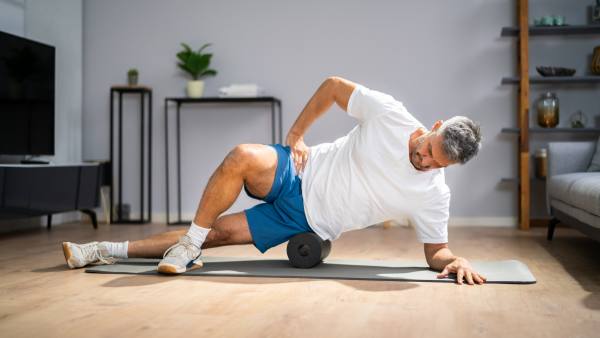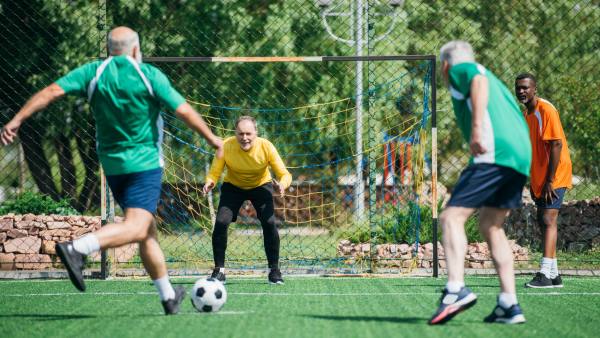Fortysomething B.C. comedian and Canadian Men’s Health Foundation National Champion Toby Hargrave hits the nail on the head when he talks about getting older in one of his stand-up routines: “I’m at that age where sometimes things hurt, and I have no idea why. If you’re 20 and show up to work with a limp, there’s always some epic adventure behind it. Today, I show up with a limp, and people are like, “What happened?” And I’m like, “I don’t know!”
Why the risk of injury climbs as we age
Turns out the mysterious aches and pains of middle age aren’t so mysterious after all. As a sports performance specialist and personal trainer who was the Director of Strength and Conditioning for the Vancouver Canucks from 2003 to 2022, I know that getting older can contribute to more frequent and severe injuries.
Guys’ muscle mass tends to decrease as we age, leading to a decline in strength and mobility. We also tend to gain weight, which puts more pressure on our joints and muscles, our reflexes slow down, and our physical coordination declines.
The good news is that you can take plenty of easy steps to reduce the risk of injury while still gaining all the incredible benefits of getting active.
Understanding the role of rest

If you’re considering getting back into working out after a few months or years off, there’s a good chance you’ll be keen to see the physical results of your efforts as soon as possible. That’s understandable. You’re working hard and want to feel and see those gains.
As your muscles age and decrease, it becomes critical that you give them enough time to bounce back after doing any physical activity. Nothing will slow your progress as quickly as an injury from pushing yourself too hard.
First, consider how much rest and recovery time your body needs. As an example, let’s consider 2 men aged 45. Both want to begin working out but have not been to the gym consistently in 4 years.
The first works as a landscaper. He’s on his feet most of the day, lifting and carrying, squatting and walking. The second works in an office and spends most of his day at his desk.
The man who works in the office may need to give his body more time to recover from these new activities than the first, as he has a lower base level of activity. His body may not be used to moving like the landscaper.
How you define “rest” will also vary from person to person. Using the same 2 guys as an example, in between workouts, the second person may want to use a rest and recovery day to take it easy. Until his body adapts to this increased activity level, he might go for a brief, slight walk or do some stretching on days off.
The first guy, however, given his activity level at work, may choose active rest, meaning instead of another workout, he will go for a walk, a swim, or a leisurely bike ride. The intent here is to allow your muscles to recover by engaging in light activity that uses different muscle groups.
All fitness levels can use recovery days for stretching/mobility work or foam rolling. These activities will engage and loosen your muscles, helping your body’s mobility.
The importance of mobility
As we get older, mobility becomes a kind of antidote to injury. Maintaining mobility—the ability to move or walk freely and easily—is one of the main benefits of regular exercise, and it’s vital to live happily and independently.
Staying mobile helps people live longer and can extend men’s life expectancy by two full years on average. It can also make life much more enjoyable. Studies show that 30 percent of adults over 70 have difficulty walking, standing up, getting out of a chair, and climbing the stairs. However, regular exercise helps prevent that from becoming a reality by keeping you mobile as you age.
How active do guys need to be?
According to the Canadian Society for Exercise Physiology’s 24-Hour Movement Guidelines, adults aged 18-64 should get at least 150 minutes of heart-pumping physical activity (aka cardio) each week. Intense workouts like hockey, soccer, distance running, basketball or tennis can hit that weekly target with rest and recovery days in between.
If you prefer lighter exercise like walking, spreading your active time throughout the week is an easy way to build up to the Guidelines. Across 7 days, you’re looking at roughly 22 minutes of physical activity daily, or smaller still, two bouts of 10 minutes daily.
Gradually increase the number of minutes you walk as your body gets fitter. If you’ve been walking 20 minutes each night for a couple of weeks, take 1 evening off, and if the next day you still feel good, try a 30-minute walk. Over time, you’ll be surprised how far and fast you can go–and maybe even how loose your pants feel!
Whatever you choose, it’s essential to take a few minutes to warm up and cool down before and after exercise to help reduce the risk of injury. On that note…
Warm up
Even if you’re pressed for time, preparing your body for physical activity with a few minutes of lighter activity beforehand is always a good idea. The benefits of this may not jump out at you, but trust me, your body will thank you later! This is especially true as we get older.
A good warm-up consists of a general cardio-based movement that gradually increases your heart rate, body temperature, and blood flow to your muscles and gets your nervous system firing on all cylinders. Walking, marching on the spot, a slow jog, that kind of thing.
Warm-ups can also involve activities that echo the more intense workout to follow. Shooting basketballs before a two-on-two game, for instance, or circling the rink a few times before hockey.
Easy cardio workouts
These simple exercises are easy to slide into your daily routine:
Walk: Does it get any more basic than putting one foot in front of the other? Walking briskly for 15 minutes burns around 125 calories, with men walking five city blocks daily lowering their risk of heart attack by 25 percent. Walk to the supermarket instead of driving, park farther away, take walking meetings, or take a nature walk with your dog.
Jumping jacks: Remember jumping jacks from grade-school gym class? Turns out this classic move can deliver an effective five-minute workout by doing them in 20-second intervals followed by a rest period of 10 seconds.
Swim: As well as being free, fun, and relaxing, swimming in an ocean, lake, river, or public pool is an excellent workout because you’re moving your whole body against the resistance of the water. This builds endurance, muscle strength and cardiovascular fitness while going easy on your joints.
Jump rope: Jumping rope is one of the most effective cardio exercises out there. A few minutes of skipping a day can really whip you into shape. Just look at this study: After 6 weeks of jumping rope for 10 minutes a day, participants demonstrated the same levels of cardio improvement as people who jogged for 30 minutes daily. Less really can be more!
Cool down

A post-exercise cooldown is just as important as the warm up. It allows the body to ‘down-regulate’ or start the recovery and regeneration process to get the most out of the workout that you just completed.
It involves deep breathing, a few minutes of gentle activity, and stretching (in that order). Take a few deep breaths if you only have a few minutes to cool down after exercise. Breathe in for 4 seconds through your nose and out through your mouth for 7-8 seconds. Do it for 2-3 mins, and it will help your body recover.
Any static stretching works well during a cooldown. While holding a static stretch, prioritize your breathing instead of the stretch. Instead of counting each time, hold the stretch for 3 long, focused breaths. This will relax your body and provide more benefits from the stretch. The goal should be to relax the muscle tissue rather than improve the range of motion.
Warming up and cooling down are often the first things we’ll skip when we go to the gym. We’re pressed for time; we have work to get to or family responsibilities waiting for us.
If you walk into the gym with 5 minutes bookmarked at the start and end of your workout for these activities, you’ll be less likely to skip them. Remember, something is better than nothing; your muscles will feel and move better, your recovery time will be shorter, and you’ll experience fewer setbacks from injury. That’s time well spent!
Exercises every man over 35 should do
The 24-Hour Movement Guidelines also report that adults should aim to do muscle-strengthening activities at least twice a week. If you’re over 35 (or getting close), these are 3 areas of exercise you’ll want to focus on.
- Mobility exercises to maintain and enhance range of motion and flexibility
- Strength training to maintain muscle mass and keep your muscles working properly
- Balance exercises to prevent falls and improve coordination
The Four Pillars of Recovery
Incorporating what I call the Four Pillars of Recovery into your daily routine, whether you’re taking part in strenuous exercise, you’ve worked your way up to walking 10 kilometres in a day, or you’re just getting back into practice, will help ensure your muscles get the rest they need to reduce your chance of injury.
Important tip: if you’re new to or returning to regular physical activity, rest and recovery days should happen about every other day.
Healthy Sleep
Sleep is the most essential aspect of recovery. Without enough of it, you may lack the energy and motivation to exercise in the first place.
Conversely, exercise can help solve sleep-related problems and give you a healthy rest. Plus, sleep helps regenerate muscle tissue and keep your decision-making, reflexes, and coordination sharp, which can reduce the risk of injury.
Nutrition and Hydration
While sleep is essential to recovery, we sweat as we sleep, and we can dehydrate slightly overnight. That’s why starting your day out with a glass of water can help get you on track for hydration. Drinking plenty of water throughout a recovery day and before a more strenuous workout is important. The way to go is to start exercise with a water surplus, not a deficit.
Because protein is the most essential nutrient for repairing muscle tissue after exercise, rest and recovery menus should include plenty of foods like chicken breast, turkey breast, lean pork, tuna, Greek yogurt, eggs, quinoa, cottage cheese, and beans and lentils.
Active Recovery
Taking part in light, low-impact exercise the day after a more strenuous workout can help your muscles recover and reduce the risk of injury the next time you kick things up a notch. An easy bike ride, swimming, and yoga are three examples of things you can do.
Social Wellbeing

Last but not least, connecting with friends and/or loved ones at least once a week can help remove barriers to exercise, such as anxiety, depression, digestive issues, headaches, muscle tension and pain, sleep problems, weight gain, and memory and concentration impairment.
Working out with a buddy or as part of a local team makes exercise more enjoyable! Plus, maybe your friend can help you figure out where that limp came from…
What are your tips for keeping your muscles loose, limber, and happy? Let us know in the comments below.
Are You at Risk?
Learn your risk level for the most common men’s health conditions in 10 minutes with a free, confidential, and personalized report.





Let’s Talk!
Did you enjoy this article? Let us know in the comments.
0 Comments